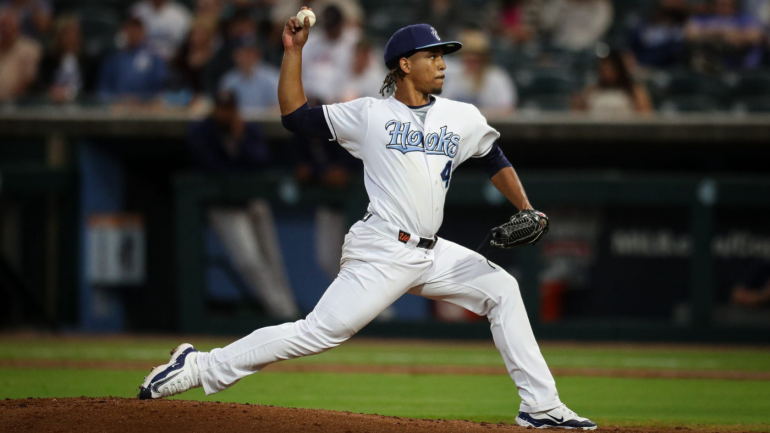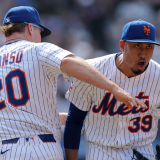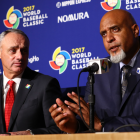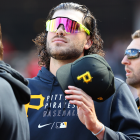2024 MLB Rule 5 Draft: Date, time, order, three players to watch and everything else to know
The Rule 5 Draft gets underway on Wednesday, Dec. 11

Major League Baseball's Winter Meetings, an annual gathering of the industry's power brokers, are underway in Dallas, Texas. The Winter Meetings often inspire a transactions frenzy for obvious reasons: executives and agents will do anything, even their jobs, to avoid interacting with hordes of credentialed media and employment seekers that flock to the premises.
As is tradition, the Winter Meetings will include the Rule 5 Draft, this year held on Wednesday, Dec. 11. There is no event on the baseball calendar that appeals more to the obsessive seamhead. Although the Rule 5 Draft is seldom relevant in the grander scheme, it's a pure distillation of what attracts a certain type to baseball: the idea that there's always a hidden gem out there, provided you have the wits and the willpower to find it.
For everyone else, you might have questions about what the Rule 5 Draft entails and how it works. Below, we've answered those inquiries and more.
1. How does the Rule 5 Draft work?
The Rule 5 Draft's mechanism is easy enough to understand. Teams can employ players for only so many years before they become eligible for the Rule 5 Draft. In turn, teams then must make a decision: protect those athletes from the draft pool by placing them on the 40-player roster, or otherwise risk losing them during the draft for a small fee ($100,000).
Eligibility for the Rule 5 Draft is tied to age and service time. Players who signed at age 19 or older are eligible beginning with the fourth subsequent Rule 5 Draft; players who signed at age 18 or younger are eligible beginning with the fifth.
There is a non-fiscal opportunity cost to selecting a player in the Rule 5 Draft: the team must then keep that player on their big-league active roster for the ensuing year. If and when the new team decides that's not a sacrifice they can make, then they can offer the player back to their original team for half the original selection fee ($50,000).
2. Why is the Rule 5 Draft a thing?
Over the years, we've had front-office types bemoan the continued existence of the Rule 5 Draft. It's pointless these days, they say, because teams have gotten better at self-scouting and at avoiding accidentally leaving valuable players exposed.
It's also potentially harmful to the players themselves, since they're placed on a development track that could impact their long-term viability at the big-league level.
Still, the Rule 5 Draft remains in motion because it serves its original intended purpose of preventing talent hoarding. Were it not for the draft, teams would have less urgency to add players to their 40-player roster, or to trade them to other organizations. The Rule 5 Draft event itself, then, is just a byproduct of fulfilling that function.
3. Who are some past Rule 5 Draft successes?
The biggest historical success stories include names like Roberto Clemente, Johan Santana, Shane Victorino, and Josh Hamilton. More recently, the best selections have been those of Ryan Pressly, Garrett Whitlock, Mark Canha, and Anthony Santander.
Last winter's Rule 5 Draft saw teams make 10 selections. Of those 10 players, seven stuck for the entire season. Carson Coleman, drafted by the Rangers from the Yankees, was returned in November after missing the past two seasons because of injury. (Coleman would have been required to spend at least 90 days on the Rangers' active roster before his rights transferred.) Here's how the other six fared:
- RHP Mitch Spence, Athletics (from Yankees): 1.6 WAR
- RHP Ryan Fernandez, Cardinals (from Red Sox): 1.0 WAR
- RHP Justin Slaten, Red Sox (from Rangers): 0.9 WAR
- INF Nasim Nuñez, Nationals (from Marlins): 0.7 WAR
- RHP Stephen Kolek, Padres (from Mariners): -0.2 WAR
- RHP Anthony Molina, Rockies (from Rays): -0.6 WAR
None of those players will be confused for franchise cornerstones, but clearly savvy clubs can walk away from the Rule 5 Draft with a useful bullpen arm or bench piece.
4. What is the Rule 5 Draft order?
In case you were wondering, there is no Rule 5 Draft lottery. The order is determined by the previous season's winning percentage. Whenever there's a tie, the superior selection goes to the team with the inferior record in the year before last (or however many years back is required to unravel the knot).
We should note that teams are under no obligation to make a selection, and only clubs with an open 40-player roster spot are allowed to partake. Those who do pick a player can trade them at any point if they so desire.
Now, here's the order of the first 10 picks in this year's Rule 5 Draft:
- Chicago White Sox
- Colorado Rockies
- Miami Marlins
- Los Angeles Angels
- Oakland Athletics
- Washington Nationals
- Toronto Blue Jays
- Pittsburgh Pirates
- Cincinnati Reds
- Texas Rangers
And so on. Just who might those teams be picking? Here are a few notable names.
Three players to keep tabs on
1. Sammy Siani, OF, Pirates
Siani is one of the most famous names available in this Rule 5 Draft. In addition to being only a few years removed from a high draft slot (the Pirates took him 37th in 2019), his older brother Michael appeared in more than 120 games last season with the Cardinals. This Siani spent most of his year in Double-A, posting league-average offense while seeing action across the outfield. He improved his strikeout rate enough that some team could talk themselves into him being a competent spare outfielder.
2. Miguel Ullola, RHP, Astros
Ullola continues to be too wild to project as a big-league starting pitcher (he walked more than five batters per nine innings over 27 appearances in Double-A). Still, we could see a team auditioning him in the bullpen during spring training. Guardians lefty Erik Sabrowski made an impression this summer by chucking his rising fastball again and again and watching opponents flail at it. Ullola's low-to-mid-90s heater has some similar qualities, including more than 20 inches of induced vertical break. Ullola's woeful command threatens to undermine his upside, but we think he's worth a look.
3. Bob Seymour, 1B, Rays
All Seymour has done as a professional is hit and then hit some more. He split last season between Double- and Triple-A, finishing 40% above the league-average in both leagues. Seymour has shown he can clobber the ball (he launched a ball over 114 mph in September), but there are some red flags here that suggest he might be overexposed in the majors. Chief among them: a 34.9% strikeout rate in Triple-A that was fueled by his aggressive, chase- and whiff-happy approach. It only takes one team to overlook Seymour's grip-and-rip mentality for him to be selected with an eye on using him at first base or DH.


















